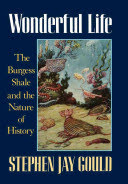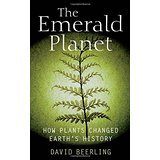Wonderful Life: The Burgess Shale and the Nature of History, by Stephen Jay Gould

This is a book about a limestone quarry in Canada. The Burgess Shale isn’t just any old quarry, however—it’s the site of one of the most important discoveries in the history of science. It contains bizarre and psychedelic aquatic fossils (one literally named Hallucigenia) from soon after the Cambrian explosion that resemble nothing alive on the Earth today.
One has five eyes on stalks, armor plating, and a tentacle mouth (Opabinia), and another glides like an armor plated shrimp/manta ray hybrid with toothed face tentacles and a circular maw as if it came from a horror film (Anomalocaris).
All of the creatures in the book are alien and fascinating, but the lessons they have to teach us about evolution are even more important. The history of evolution isn’t one of mere increasing diversity over time—what so often gets depicted as the tree of life—it’s full of bizarre offshoots, huge branches that suddenly die off, and immense sideways growths.
The world today isn’t the inevitable result of evolution—if we were to run the whole thing all over again, there’s nothing to say that it would go the same way again. If you do decide to read this book, there is one caveat, however: It was initially published in 1989, and while most of the science is still good, there have been minor updates to our understanding of a couple of the creatures depicted, notably Hallucigenia.
The Emerald Planet: How Plants Changed Earth’s History, by David Beerling

The evolution of plants is a story that often gets ignored in favor of the evolution of animals. An ancient fern just isn’t as interesting to most people as a dinosaur or giant armor plated fish—they lack a certain degree of flashiness. It’s a story that shouldn’t be ignored though, and in many ways, it’s by far the more important one.
Plants provide some of the most vital clues towards understanding the history of our planet. One fossil plant, Glossopteris, was one of the primary pieces of evidence that lead geologists to formulate the idea of plate tectonics. Plants help regulate the climate, alter the makeup and density of the atmosphere, and even alter the workings of geological processes on a global scale. They're even thought to have contributed to one of the world's mass extinctions, after they first migrated onto land.
I originally wrote a version this article for Portland Community College's student newspaper The Bridge. I retain all rights to writing I did for The Bridge.
reSteemed
Downvoting a post can decrease pending rewards and make it less visible. Common reasons:
Submit
Thanks!
Downvoting a post can decrease pending rewards and make it less visible. Common reasons:
Submit
Great work once again. I find prehistoric evolution to be a fascinating topic and have been to several sites where large numbers of fossils are found. It's simply amazing how we have this record of a world that was unlike anything we see today. It seems to me that periods such as the Cambrian Explosion were times when evolution went through highly experimental stages. Understanding why a particular species survived, whilst others died is essential for the conservation efforts in our time.
Downvoting a post can decrease pending rewards and make it less visible. Common reasons:
Submit
Oh, definitely!
This is pretty nerdy, but I've definitely drawn a lot of my philosophy of history from Wonderful Life and Gould in specific and geology in general- there is a surprising amount of crossover between history and geological history, at least philosophically.
Downvoting a post can decrease pending rewards and make it less visible. Common reasons:
Submit
I am Groot! :D
Downvoting a post can decrease pending rewards and make it less visible. Common reasons:
Submit